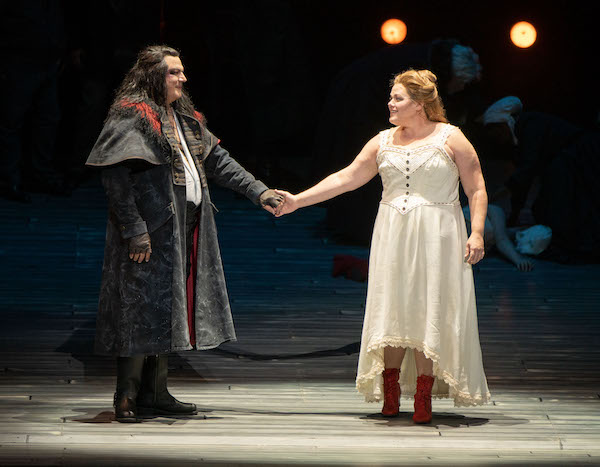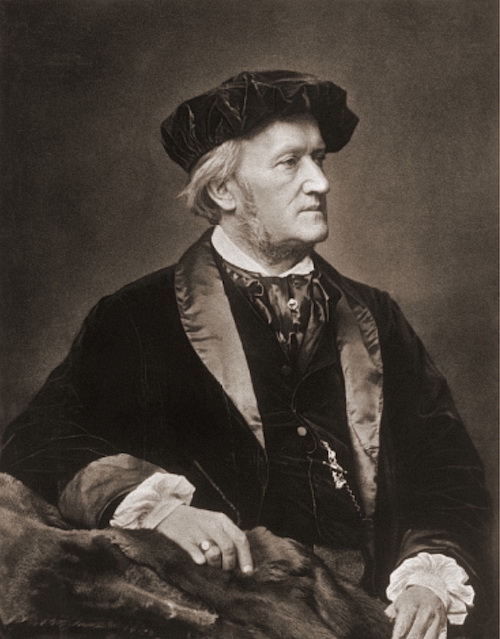Utah Opera soars with Wagner’s “Flying Dutchman”
The Flying Dutchman is the one Wagner opera that can serve gracefully as a staple of regional opera companies.
That is partly due to its brevity. Dutchman clocks in at under three hours, which means it can be produced without paying overtime rates—a genuine issue with Wagner’s other works, most of which are over four hours long and require larger orchestras.
The opera also gives audiences a taste of Wagner without taxing attention spans. Although Wagner wrote it before he had fully developed his distinctive style, Dutchman foreshadows many of the elements of his more mature works; the title character’s rousing leitmotiv feels a bit like the “Ride of the Valkyres,” and the titanic, ultimately fatal longing between him and his love interest calls to mind Tristan and Isolde.
Utah Opera is opening its season with a revival of The Flying Dutchman, which opened Saturday night at the Lawson Capitol Theatre. The production had been rescheduled from October 2020 due to the pandemic.
In the company’s current Dutchman, Wendy Bryn Harmer finally got to play Senta. Her performance surpassed the already high expectations raised by her solo tour de force in Poulenc’s La Voix Humaine (which replaced the cancelled Dutchman two years ago).
From the moment Senta first appears, she is fixated on the ghostly legend, and Harmer found the emotional truth in her character’s obsession. Her powerful voice maintained a mellow, rounded tone then unleashed its full strength during her solo passages, when she sang about the Dutchman. Every breath reached the back wall of the theatre, and the depth of Senta’s feeling was reflected in Harmer’s tone and phrasing.
The production’s high points were Harmer’s duets with Michael Chioldi as the Dutchman, and the pair’s chemistry was palpable from the moment their characters met. Chioldi, who last worked with Utah Opera in its 2019 production of La Traviata, has a deep, rich voice that matched Harmer in power and intensity, and he displayed striking musicality, especially when singing directly to Senta. While Chioldi appeared cold and somewhat stiff in the first act, he gave his character a weight and gravitas that made his suffering real and believable as the production progressed.
In contrast to Harmer’s otherworldly duets with Chioldi, her duets with Robert Stahley were fractious and earthbound. Making his Utah Opera debut, Stahley played Senta’s suitor, Erik, with the petulance and menace of a toxic boyfriend, and Harmer reacted with fear. In their first duet, where they fought over the book containing the legend of the Dutchman, Senta appeared to be saying what she needed to say to soothe his potentially violent temper. Stahley’s clear, sharp tenor contrasted with the Chioldi’s bass-baritone, accentuating the differences between their characters.
Kristin Sigmundsson, making his Utah Opera Debut as Senta’s father Daland, also provided an earthy foil to the Dutchman. Although he is a bass, Sigmundsson’s voice had a light, buoyant quality, which matched his character’s simplicity. His posture and facial expressions were clear and comical as he bartered Senta to the Dutchman in exchange for treasure, having no idea he was dealing with the tormented ghost of legend. He also added comic relief when he introduced Senta and the Dutchman and was baffled by the depth of their emotion as they stood transfixed with one another.
Under the baton of Ari Pelto—returning to Utah Opera after last season’s La tragédie de Carmen— the Utah Symphony shimmered and buzzed with energy, propelling the nautical adventure forward with a strong rhythmic drive. The strings and brass blended particularly well in the overture, creating a rich full sound, after which the curtain opened on the three-dimensional trapezoid that would form the physical set through all three acts.
The set by production designer Ian Wallace and set designer Steven C. Kemp could be experienced as both realistic and abstract. Made of planks of weathered wood, it called to mind the hull of a ship, even though none of the opera’s action took place in that setting. This was somewhat confusing in the first scene, in which Captain Daland disembarks from the bow of his ship onto what is supposed to be the shore but looks like the inside of another ship.
Whether or not it was intentional, the monotony of the set created a sense of claustrophobia that focused the mind on the Dutchman’s tormented existence and highlighted the psychological drama.
Fortunately, the projections by lighting designer Ben Rawson helped visually. Such was the case with the inside of the captain’s house, where a coastal winter scene was projected on the back wall and could be seen through three windows on a wall that was placed there during Act II.
Throughout the production, different events and settings were projected on the back and side walls—including the ocean in a storm, the approach of the Dutchman’s ghost ship, and at a few memorable moments, the 30-foot-tall image of Chioldi as the Dutchman.
Director Andreas Hager, making his Utah Opera debut, did an excellent job highlighting that drama, opting for stillness and intensity in Senta’s scenes with the Dutchman while making the group scenes appropriately busy and frenetic. Perhaps Hager’s greatest strength was his sense of pacing, as he let the emotion grow at a slow burn to the cathartic denouement.
The group scenes were made more effective by the clear, robust sound of the chorus, under the direction of Melanie Malinka.
The Flying Dutchman runs through October 16 at the Lawson Capitol Theatre. utahopera.org

